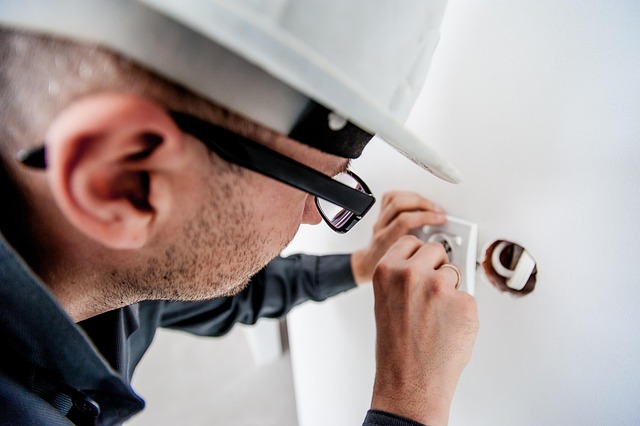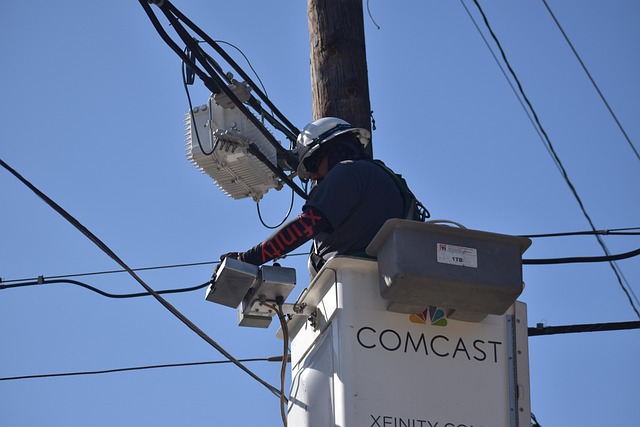Identifying and addressing common electrical issues like flickering lights, overloaded circuits, and faulty outlets is crucial for home safety. Electricians use specialized tools to diagnose problems, prioritize safety with protective gear, and follow local codes. Regular maintenance, swift action on minor issues, and understanding when to seek professional help ensure a reliable and safe electrical system, preventing hazards like fires or shocks.
Are you tired of flickering lights or power outages? Learn how to tackle common circuit faults and outlet issues with this comprehensive guide. From identifying problem areas to performing repairs, we’ll equip you with the knowledge to keep your home’s electrical system running smoothly. Discover essential tools and safety precautions for electricians, follow a step-by-step repair guide, and know when it’s time to call a professional. Become your own electrician and ensure a safe, reliable power source for your family.
- Identify Common Circuit Faults and Outlets Issues
- Tools and Safety Precautions for Electricians
- Step-by-Step Guide to Repairs and Maintenance
- When to Call a Professional Electrician
Identify Common Circuit Faults and Outlets Issues

Identifying common circuit faults and outlet issues is a crucial step in repairing electrical problems. Some frequent issues include flickering lights, tripping circuits, and outlets that don’t work or feel warm to the touch. These problems can be caused by various factors such as faulty wiring, overloaded circuits, or worn-out components. A qualified electrician can help pinpoint these issues using specialized tools and testing procedures to ensure accurate diagnoses.
For instance, an electrician might check for loose connections, damaged insulation, or short circuits that can cause power surges and arcing. By addressing these problems promptly, homeowners can prevent serious safety hazards like fires or electrical shocks. Regular maintenance and timely repairs by a professional electrician are essential to keeping your home’s electrical system reliable and safe.
Tools and Safety Precautions for Electricians

When tackling repairs for faulty circuits or electrical outlets, electricians require a specific set of tools tailored for safety and efficiency. A voltage tester is essential to check for power sources, ensuring work areas are de-energized before beginning any repair. Wire strippers help in removing insulation while leaving wires intact, preventing accidental shorts or damage. Pliers come in various types, each designed for specific tasks like bending, cutting, or gripping wires and components securely.
Safety precautions are paramount for electricians. Protective gear, including insulated gloves, safety glasses, and work boots, shields against electrical hazards. Always turning off the main power supply at the breaker box before beginning any repair is non-negotiable. Moreover, understanding and adhering to local electrical codes ensures safe installations and protects against potential risks associated with faulty wiring.
Step-by-Step Guide to Repairs and Maintenance

Repairs and maintenance are essential parts of keeping your home’s electrical system in top condition. If you notice a faulty circuit or outlet, don’t panic; you can often fix the issue yourself with a few simple steps. Here’s a step-by-step guide to help you get started.
1. Safety First: Turn off the power at the main electrical panel before beginning any work. This is crucial to prevent accidents and ensure your safety as an electrician. Use a voltage tester to confirm the power is off before proceeding.
2. Identify the Problem: Inspect the faulty outlet or circuit to determine the issue. Common problems include a loose connection, a burned-out fuse, or a faulty breaker. Look for signs of damage, overheating, or unusual odors that might indicate a more serious problem.
3. Replace Fuses or Reset Breakers: If you identify a blown fuse, replace it with one of the same amperage rating. For resetable breakers, simply flip the switch back on. This is often the quickest and easiest fix for a faulty circuit.
4. Tighten Connections: Check all connections at the outlet or fixture for any loose wires. Tighten them securely using pliers to ensure proper conductivity.
5. Repair or Replace as Needed: If an outlet is damaged, consider replacing it. For more complex issues, such as old wiring or serious damage, it’s best to call a professional electrician.
When to Call a Professional Electrician

If you’re faced with a faulty circuit or electrical outlet, it might be tempting to attempt a DIY repair. However, there are certain scenarios where it’s best to call in a professional electrician. For instance, if the problem involves exposed wiring, flickering lights, or outlets that overheat, it’s crucial to leave these repairs to the experts. These situations could indicate serious issues with your electrical system, and attempting to fix them yourself may pose significant safety risks or even lead to further damage.
Professional electricians are equipped with the right tools and knowledge to diagnose complex problems accurately. They can identify potential hazards, such as outdated wiring or faulty installations, which might be beyond the scope of a layperson’s skill set. Plus, hiring a licensed electrician ensures your work complies with local safety regulations, providing peace of mind and protecting your home from electrical fires or other accidents.
Repairs and maintenance of faulty circuits and outlets are essential aspects of electrical safety, often requiring the expertise of a professional electrician. By identifying common issues, understanding safety precautions, and following a structured guide, homeowners can tackle minor problems. However, for more complex repairs or when unsure, it’s advisable to call an electrician to ensure a safe and effective solution. Regular maintenance and prompt attention to faults are key in preventing hazardous electrical situations.
